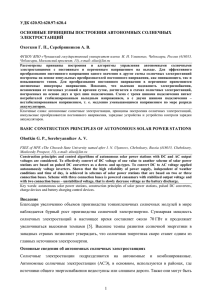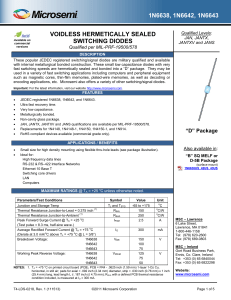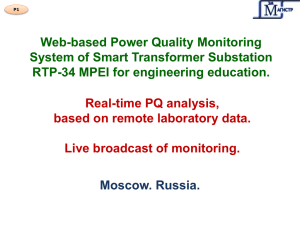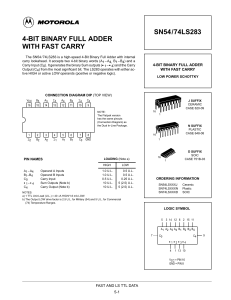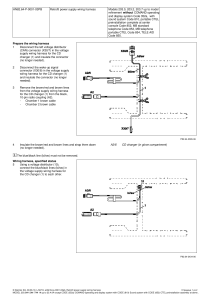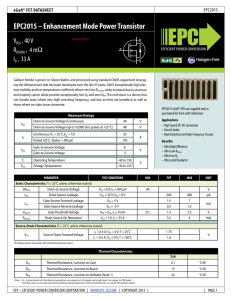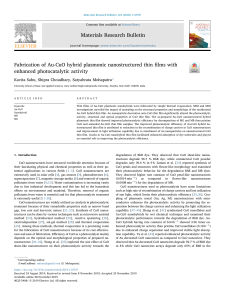Haye-Phenomenological study of iron and lanthanum magnetron co-sputtering using two reactive gases-2016
реклама
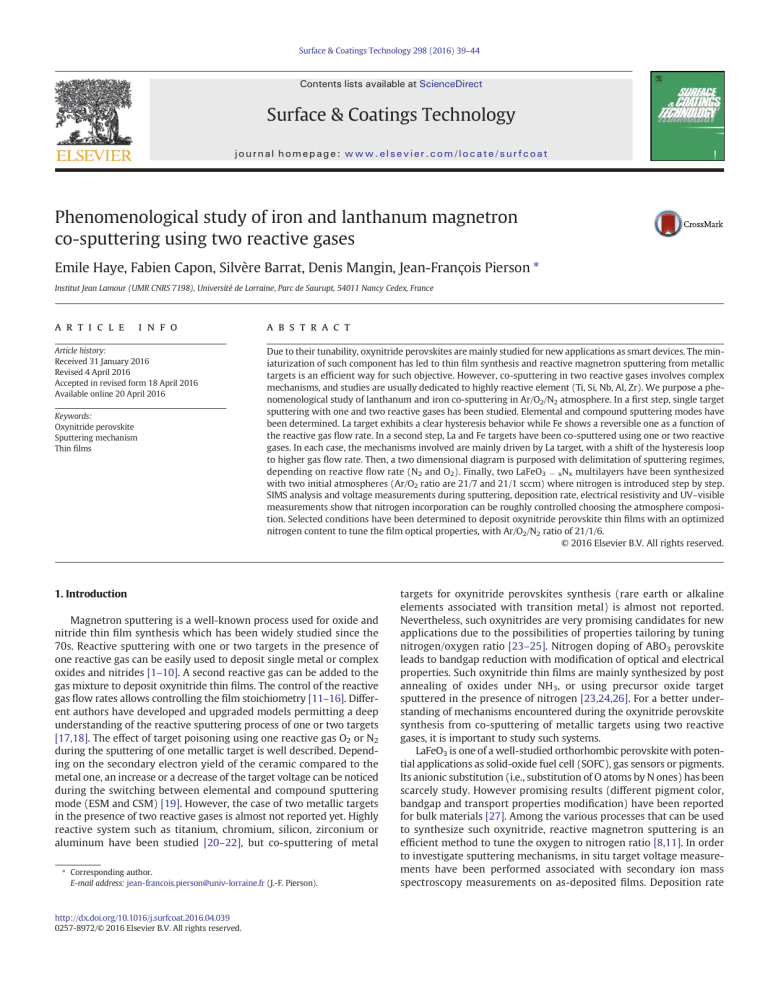
Surface & Coatings Technology 298 (2016) 39–44 Contents lists available at ScienceDirect Surface & Coatings Technology journal homepage: www.elsevier.com/locate/surfcoat Phenomenological study of iron and lanthanum magnetron co-sputtering using two reactive gases Emile Haye, Fabien Capon, Silvère Barrat, Denis Mangin, Jean-François Pierson ⁎ Institut Jean Lamour (UMR CNRS 7198), Université de Lorraine, Parc de Saurupt, 54011 Nancy Cedex, France a r t i c l e i n f o Article history: Received 31 January 2016 Revised 4 April 2016 Accepted in revised form 18 April 2016 Available online 20 April 2016 Keywords: Oxynitride perovskite Sputtering mechanism Thin films a b s t r a c t Due to their tunability, oxynitride perovskites are mainly studied for new applications as smart devices. The miniaturization of such component has led to thin film synthesis and reactive magnetron sputtering from metallic targets is an efficient way for such objective. However, co-sputtering in two reactive gases involves complex mechanisms, and studies are usually dedicated to highly reactive element (Ti, Si, Nb, Al, Zr). We purpose a phenomenological study of lanthanum and iron co-sputtering in Ar/O2/N2 atmosphere. In a first step, single target sputtering with one and two reactive gases has been studied. Elemental and compound sputtering modes have been determined. La target exhibits a clear hysteresis behavior while Fe shows a reversible one as a function of the reactive gas flow rate. In a second step, La and Fe targets have been co-sputtered using one or two reactive gases. In each case, the mechanisms involved are mainly driven by La target, with a shift of the hysteresis loop to higher gas flow rate. Then, a two dimensional diagram is purposed with delimitation of sputtering regimes, depending on reactive flow rate (N2 and O2). Finally, two LaFeO3 − xNx multilayers have been synthesized with two initial atmospheres (Ar/O2 ratio are 21/7 and 21/1 sccm) where nitrogen is introduced step by step. SIMS analysis and voltage measurements during sputtering, deposition rate, electrical resistivity and UV–visible measurements show that nitrogen incorporation can be roughly controlled choosing the atmosphere composition. Selected conditions have been determined to deposit oxynitride perovskite thin films with an optimized nitrogen content to tune the film optical properties, with Ar/O2/N2 ratio of 21/1/6. © 2016 Elsevier B.V. All rights reserved. 1. Introduction Magnetron sputtering is a well-known process used for oxide and nitride thin film synthesis which has been widely studied since the 70s. Reactive sputtering with one or two targets in the presence of one reactive gas can be easily used to deposit single metal or complex oxides and nitrides [1–10]. A second reactive gas can be added to the gas mixture to deposit oxynitride thin films. The control of the reactive gas flow rates allows controlling the film stoichiometry [11–16]. Different authors have developed and upgraded models permitting a deep understanding of the reactive sputtering process of one or two targets [17,18]. The effect of target poisoning using one reactive gas O2 or N2 during the sputtering of one metallic target is well described. Depending on the secondary electron yield of the ceramic compared to the metal one, an increase or a decrease of the target voltage can be noticed during the switching between elemental and compound sputtering mode (ESM and CSM) [19]. However, the case of two metallic targets in the presence of two reactive gases is almost not reported yet. Highly reactive system such as titanium, chromium, silicon, zirconium or aluminum have been studied [20–22], but co-sputtering of metal ⁎ Corresponding author. E-mail address: jean-francois.pierson@univ-lorraine.fr (J.-F. Pierson). http://dx.doi.org/10.1016/j.surfcoat.2016.04.039 0257-8972/© 2016 Elsevier B.V. All rights reserved. targets for oxynitride perovskites synthesis (rare earth or alkaline elements associated with transition metal) is almost not reported. Nevertheless, such oxynitrides are very promising candidates for new applications due to the possibilities of properties tailoring by tuning nitrogen/oxygen ratio [23–25]. Nitrogen doping of ABO3 perovskite leads to bandgap reduction with modification of optical and electrical properties. Such oxynitride thin films are mainly synthesized by post annealing of oxides under NH3, or using precursor oxide target sputtered in the presence of nitrogen [23,24,26]. For a better understanding of mechanisms encountered during the oxynitride perovskite synthesis from co-sputtering of metallic targets using two reactive gases, it is important to study such systems. LaFeO3 is one of a well-studied orthorhombic perovskite with potential applications as solid-oxide fuel cell (SOFC), gas sensors or pigments. Its anionic substitution (i.e., substitution of O atoms by N ones) has been scarcely study. However promising results (different pigment color, bandgap and transport properties modification) have been reported for bulk materials [27]. Among the various processes that can be used to synthesize such oxynitride, reactive magnetron sputtering is an efficient method to tune the oxygen to nitrogen ratio [8,11]. In order to investigate sputtering mechanisms, in situ target voltage measurements have been performed associated with secondary ion mass spectroscopy measurements on as-deposited films. Deposition rate 40 E. Haye et al. / Surface & Coatings Technology 298 (2016) 39–44 Table 1 Experimental conditions. Pressure 0.5 Pa Distance Fe target — substrate holder Distance La target — substrate holder Current on Fe target Power on La target Oxygen flow rate range Nitrogen flow rate range 7 cm 5.5 cm 0.2 A 110 W 0–10 sccm 0–30 sccm and electrical resistivity measurements have been also used to support explanations due to the direct influence of nitrogen and oxygen content. UV–visible spectrometry is also used as direct signature of the qualitative nitrogen content on the optical band gap. 2. Experimental LaFeO3 and LaFeO3 − xNx films were deposited by reactive magnetron co-sputtering from two metallic targets in a 50 L chamber, equipped with turbomolecular pump backed by a mechanical pump. Iron target (diameter: 50 mm, thickness: 0.25 mm, purity: 99.5%) was sputtered by DC sputtering, while lanthanum (diameter: 50 mm, thickness: 3 mm, purity: 99.9%) was sputtered with pulsed-DC (50 kHz, toff = 4 μs). The base pressure before deposition was close to 10−5 Pa. Argon, oxygen and nitrogen flow rates were controlled by Alphagaz mass flowmeters with a resolution of 0.5 sccm. Preliminary trials permitted to optimize the distances between targets and substrate rotating holder. The distance was 7 cm for iron, while that of lanthanum was 5.5 cm. The sputtering of the iron target was performed at a constant current while the power was fixed for the La target [28]. Table 1 summarizes the deposition conditions used within this work. Electrical resistivity measurements at room temperature were performed using the 4 point probe method. The deposition rate was estimated from thickness measurements using a tactile profilometer. UV–visible measurements were performed using a Varian Cary 5000 spectrophotometer. Secondary ion mass spectroscopy (SIMS) measurements have been performed with Cs+ ion with Cameca IMS7F. 3. Results and discussion 3.1. Instability region of Fe, La and Fe–La systems in Ar/O2, Ar/N2 and Ar/O2/ N2 mixtures Before studying the deposition of oxynitride perovskite thin films, preliminary experiments have been performed using one or two targets and only one reactive gas (O2 or N2). The effect of the oxygen flow rate on the target voltage of a single target sputtering is presented in Fig. 1a. The behavior of iron and lanthanum targets is clearly different. Before introducing oxygen, the voltage on the La target is approx. 325 V, corresponding to the elemental sputtering mode (ESM). An abrupt decrease of the voltage to approx. 115 V is noticed when the oxygen flow rates exceeds 2 sccm and the target is working in the compound sputtering mode (CSM) [29,30]. The hysteresis loop is attributed to getter effect [31,32]. On the other hand, the evolution of the iron target voltage as a function of the oxygen flow rate is quite reversible [1]. Hysteresis is too thin to be clearly observed, and the behavior of the target is considered to be almost reversible. Determination of elemental and compound mode is not easy due to continuous voltage variation: films of FexOy have been synthesized at 2 and 4 sccm, and are partially transparent, indicating that CSM is reached from 2 sccm. However, we assume that fully sputtering mode is reached when voltage stays constant, indicating stabilization of secondary electron emission coefficient and complete target poisoning, even if compound sputtering mode is observed with lower reactive flow rate. The co-sputtering of these two targets in Ar–O2 mixtures does not modify the shape of the target voltage variation: La still exhibits an instability while a reversible process is evident for Fe (Fig. 1b). However, the transition regime on La target is shifted to higher oxygen flow rate (+0.5 sccm) when two targets are sputtered. Such an increase can be explained considering the increase of the sputtered atoms flux and the oxygen consumption by the Fe target. Then, a higher amount of oxygen is required to fully oxidize the La target. Such a shift is hardly observed on the less reactive iron target. Since metallic atoms are less reactive with nitrogen than oxygen, a wider flow rate range has been studied for the sputtering of La and Fe targets in Ar/N2 reactive mixtures. The La target voltage evolution as a function of the nitrogen flow rate (Fig. 2a) is different to that previously obtained using oxygen. Within the 0–2.5 sccm range, a slight increase from 325 to 345 V is noticed. After reaching a maximum value, the La target voltage decreases slightly. This behavior can be attributed to the change of the secondary electron emission coefficient, due to chemisorption of reactive species [33]. Further increase of the nitrogen flow rate comes with an abrupt decrease of the voltage, suggesting a transition in the sputtering mode at 7 sccm from ESM to CSM. A change of the plasma color is also noticed during this transition due to change of excited species. However, the hysteresis width is low, i.e. approx. the nitrogen flow rate step used to plot this figure (0.5 sccm). In the CSM, a continuous decrease of the target voltage is still evident. It may be attributed to the gradual increase of the target poisoning and to the related significant increase of deposition pressure due to the rather low pumping speed. The shape of the iron target voltage as a function of the nitrogen flow rate (Fig. 2a) strongly differs from that obtained using oxygen as reactive gas (Fig. 1a). However a reversible behavior is still noticed. After a slight increase of the voltage, a stabilization occurs when the flow rate exceeds 10 sccm, indicating a fully compound sputtering mode. The reversible behavior of the Fe target alone in Ar/ O2 and Ar/N2 is in accordance with previous study from Petitjean et al. [1]. Due to lower reactivity of La and Fe with nitrogen compared to Fig. 1. Evolution of the iron and lanthanum target voltage as a function of the oxygen flow rate. (a) Fe and La targets are sputtered separately; and (b) Fe and La targets are co-sputtered. E. Haye et al. / Surface & Coatings Technology 298 (2016) 39–44 41 Fig. 2. Evolution of the iron and lanthanum target voltage as a function of the nitrogen flow rate. (a) Fe and La targets are sputtered separately, and (b) Fe and La targets are co-sputtered. oxygen, metallic regime is stabilized until higher nitrogen flow rate. The co-sputtering of La and Fe targets does not modify the shape of the voltage — flow rate curve (Fig. 2b). A slight shift to higher nitrogen flow rate is evident to the higher consumption of nitrogen resulting from the increase of the sputtered atom amount. Whatever the reactive gas, the sputtering mode is driven by La target, while Fe target seems to exhibit continuous evolution of mechanisms, acting like buffer target. When two reactive gases are introduced, mechanisms are more complex. Atmosphere with argon and low oxygen content (1 sccm) is initially introduced, with progressive addition of N2. When the targets are sputtered separately, the iron one exhibits a behavior intermediate between that observed with oxygen and with nitrogen (Fig. 3a). A maximum value of the voltage is obtained at approx. 2.5 sccm. Further increase of the nitrogen flow rate induces a progressive decrease of the target voltage of approx. 20 V. Considering the low value of oxygen introduced in the chamber (1 sccm), and results of Fig. 1, all oxygen is consumed by getter effect. Thus, the nitrogen flow rate value necessary to get the maximum of the iron target voltage is shifted to lower value compared to that obtained using only nitrogen as reactive gas. The La target also exhibits an intermediate behavior when the two reactive gases are introduced. In the 0–2 sccm range, a maximum of the target voltage is evident as for sputtering of lanthanum in Ar/N2 reactive mixture. At 3 sccm of nitrogen, an abrupt decrease of the voltage is noticed indicating the transition from ESM to CSM. However, the target voltage does not reach its minimal value at 3.5 sccm; a progressive decrease of the voltage is observed in the 3.5–10 sccm range to reach a quite constant value of 120 V. The hysteresis width is about the same as that measured in Ar/O2 mixture. Thus, even using a low oxygen flow rate that does not change the sputtering mode when used as the sole reactive gas, the behavior of iron and lanthanum targets in Ar/O2/N2 mixtures is mainly driven by the presence of oxygen. When both targets are sputtered in Ar/O2/N2 mixtures (Fig. 3b), the results slightly differ from those obtained during the sputtering of a single target. The iron target exhibits a voltage — flow rate curve very close to that obtained during the co-sputtering in Ar/N2. Such a result indicates that the oxygen atoms are mainly consumed by lanthanum ones. Thus, the amount of oxygen that is gettered on the iron target is not high enough to influence the target voltage. On the other hand, the shape of the lanthanum voltage — nitrogen flow rate curve differs from that obtained during the single sputtering of the rare earth. The main difference is noticed on the decrease of the nitrogen flow rate. A progressive increase of the voltage is observed during the cosputtering due to the less consumption of oxygen atoms. This synergetic effect allows reaching the CSM for both La and Fe targets at lower nitrogen flow rate for La than for the use of an Ar/N2 mixture. From previous studied cases, it is possible to identify instability regions, elemental and compound sputtering modes of Fe and La system in Ar/O2/N2 system (Fig. 4). This diagram was plotted using the target voltage — gas flow rate curves as discussed before. Upper limit of La and Fe instability region follows a linear behavior when two reactive gases are introduced indicating a synergic effect of O2 and N2. 3.2. Relation between atmosphere and film composition: multilayer synthesis From diagram of Fe–La system in Ar–O2–N2 atmosphere, we purpose to investigate evolution of oxygen and nitrogen contents of two LaFeO3 − xNx films. Two multilayered samples have been synthesized using two different Ar/O2 mixtures: 21/1 and 21/7 sccm. For both atmospheres, nitrogen has been progressively added to deposit the multilayers. For each nitrogen flow rate, the deposition duration has been fixed to 30 min (Table 2). The different atmospheres used are Fig. 3. Evolution of the iron and lanthanum target voltage as a function of the nitrogen flow rate in Ar/O2/N2 atmosphere with DO2 = 1 sccm. (a) Fe and La targets are sputtered separately; and (b) Fe and La targets are co-sputtered. 42 E. Haye et al. / Surface & Coatings Technology 298 (2016) 39–44 Fig. 4. 2D diagram of La–Fe system in Ar/O2/N2 atmosphere. Table 2 Gas flow rate conditions for multilayers synthesis. Multilayer A (high oxygen content) Multilayer B (low oxygen content) Time (min) qAr (sccm) qO2 (sccm) qN2 (sccm) qAr (sccm) qO2 (sccm) qN2 (sccm) 0 30 60 90 120 150 180 210 240 270 300 330 360 21 21 21 21 21 21 21 21 21 21 21 21 21 7 7 7 7 7 7 7 7 7 7 7 7 7 0 1 3 5 7 9 11 15 19 21 23 27 29 21 21 21 21 21 21 21 21 21 21 21 21 1 1 1 1 1 1 1 1 1 1 1 1 0 1 3 5 7 9 11 15 19 21 25 29 represented with green symbols in Fig. 4. Evolution of electrical parameters at different N2 flow rates is measured and reported for both multilayers A and B. To ensure a stabilization of the target voltage, this parameter has been systematically measured 20 min after the change of the nitrogen flow rate. Considering our 2D diagram of La–Fe system in Ar/O2/N2 atmosphere no significant change must be observed on the deposition parameter of the multilayer A, in contrary to the multilayer B. For the multilayer A (deposited with 7 sccm of oxygen), the lanthanum target voltage is low (approx. 125 V) indicating that this target is working in the compound sputtering mode (Fig. 5a). Addition of nitrogen into the chamber leads to a slight decrease of Fe voltage and a slight increase is noticed on the lanthanum target voltage. These variations are attributed to increase of the total pressure inside the chamber that modifies the plasma conditions on both targets. Nevertheless, La target is less affected due to higher mass and lower secondary electron emission coefficient. These results clearly indicate that addition of nitrogen into the 21/7 Ar/O2 reactive mixture does not induce a change of the sputtering regime for both targets. SIMS analysis shows a constant concentration of La, Fe and O elements (Fig. 5b). Signal of Cs+ ions exhibits discontinuity between each layer (not shown here) and has been used to identify each layer and to link analysis time and different layers (each layer for different nitrogen contents, top and bottom axis in Figs. 5b and 6b). Nitrogen concentration increases progressively until stagnation of concentration (at 2000 s of measurements), corresponding to a flow rate of 7 sccm. At higher N2 flow rate, saturation occurs, without evolution of the atomic N/O ratio. The drop of N signal at approx. 3000 s (i.e., near the substrate), corresponds to the transition from the layer deposited without N2 to the layer deposited using 1 sccm of nitrogen. SEM cross section analysis of the multilayer A only shows a dense microstructure with no evolution with the nitrogen flow rate (not shown here). Such a behavior can be explained considering that this multilayer is deposited in the CSM. Due to initial fully compound mode, this 21/7/x atmosphere can be used to obtain films with very low nitrogen content. UV–visible measurements performed on 21/7/7 film exhibit a similar transmittance than LaFeO3 films, with low shift of transmission edge, which confirms low nitrogen content. The decrease of the oxygen flow rate to 1 sccm (multilayer B) changes drastically the sputtering conditions (Fig. 6a). At low nitrogen flow rate the lanthanum target exhibits a voltage of approx. 300 V that is characteristic of a target working in ESM. The same behavior is true for the iron target. The progressive increase of the nitrogen flow rate induces a decrease of the lanthanum target voltage as previously reported in Fig. 3b suggesting a change of the plasma conditions and then of the film composition. SIMS depth profiles support this hypothesis (Fig. 6b). Contrary to the multilayer A, the SIMS depth profiles of Fe and La tend to decrease with the increase of the nitrogen flow rate. Such a behavior can be explained considering the decrease of the film deposition rate as confirmed on the film cross section (Fig. 7). As a function of the nitrogen rate, different layer morphologies are evident. Close to the silicon substrate (i.e., low nitrogen flow rate) a columnar morphology is observed, in accordance with metallic coatings. The increase of the nitrogen partial pressure induces a vanishing of the columnar microstructure and the layers close to the top surface exhibit a dense morphology that is more usually encountered for oxide or Fig. 5. (a) Evolution of the Fe and La target voltage as a function of the nitrogen flow rate during the deposition of the multilayer A (QO2 = 7 sccm). (b) Evolution of the La, Fe, O and N depth profile as a function of the SIMS analysis time. The corresponding nitrogen flow rate is indicated on the top axis. E. Haye et al. / Surface & Coatings Technology 298 (2016) 39–44 43 Fig. 6. (a) Evolution of the Fe and La target voltage as a function of the nitrogen flow rate during the deposition of the multilayer B (QO2 = 1 sccm). (b) Evolution of the La, Fe, O and N depth profile as a function of the SIMS analysis time. The corresponding nitrogen flow rate is indicated on the top axis. nitride films deposited in similar conditions (same morphology than multilayer A). Addition of nitrogen into the chamber modifies sputtering mechanisms with switch between elemental to compound sputtering mode. Between 0 and 1 sccm of N2, La and Fe targets voltages correspond to elemental mode, with low N and O content into the film (drop of N signal at 9000 s, near the substrate). Within our deposition conditions, the reactive gases are fully consumed by the surfaces due to the getter effect. Between 3 and 5 sccm, voltage on target exhibits a large modification, indicating switching of sputtering mode (at 3 sccm on La target and 5 sccm on Fe target). The switching between sputtering mode affects drastically the deposition rate, which drops from 3000 nm/h at 21/1/0 to 900 nm/h at 21/1/5. Beyond 5 sccm, getter effect is fully completed, leading to target poisoning by oxygen and nitrogen. Due to constant oxygen amount in the chamber with drop of deposition rate, the relative oxygen content into the film increases with nitrogen flow rate as evident in Fig. 6b. The increase of the nitrogen flow rate from 5 to 25 sccm leads to an increase of the total pressure into the chamber. Thus, the deposition rate exhibits a slight decrease (from 900 nm/h at 21/1/5 to 650 nm/h at 21/1/25) due to the decrease of the mean free path species. However from 7 sccm, the absolute nitrogen content slightly decreases. In the same time, oxygen content slightly increases. Since iron and lanthanum atoms react with oxygen rather than with nitrogen, the decrease of the film deposition rate associated with a constant oxygen flow rate induces that the film nitrogen content does not evolve monotonously with the nitrogen flow rate. Thus, an optimum nitrogen flow rate window (approx. 5–10 sccm) allows the deposition of a film with the highest nitrogen content. Resistivity measurements performed on films deposited at 21/1/0, 21/1/2, 21/1/4, 21/1/6, 21/1/8, 21/1/15 and 21/1/25 gas mixtures exhibit an increase of resistivity until 6 sccm, due to formation of oxynitride, in accordance with deposition rate measurements. It confirms the high nitrogen content obtained between 5 and 10 sccm. To confirm the beneficial effect of nitrogen doping of LaFeO3, UV–visible spectrophotometry measurements have been performed (Fig. 8). Pure oxide film exhibits a high transmittance with an optical band gap of approx. 2.5 eV. The film deposited using the 21/7/7 mixture is still highly transparent and a slight shift of the transmittance edge is noticed. Thus, the film deposited with high oxygen flow rate exhibits properties very close to those of pure oxide films because of the low nitrogen content. On the other hand, the use of a 21/1/6 gas mixture to deposit an oxynitride implies a large shift of the absorption threshold. Furthermore, a decrease of the transmittance is evident. 4. Conclusion To deposit oxynitride perovskite thin films, a study of the cosputtering process of lanthanum and iron targets using two reactive gases has been performed. The target voltage variation during evolution of the reactive gas flow rates has been used to define different sputtering modes (elemental, instability and compound). La target exhibits hysteresis effect with large transition regime and drives the Fig. 7. SEM observation of sample B cross section. 44 E. Haye et al. / Surface & Coatings Technology 298 (2016) 39–44 Fig. 8. Evolution of transmittance as a function of wavelength for films synthesized in different Ar/O2/N2 atmospheres. system in the presence of two targets. However, the iron target presents a reversible behavior, without hysteresis and act as a buffer target in the presence of two targets. Addition of small oxygen amount into the chamber leads to stabilization of compound regime at low nitrogen content. A synergic effect between nitrogen and oxygen is purposed to explain this result. Then, two multilayer LaFeO3 − xNx have been synthesized from two different Ar/O2 atmospheres (21/1 and 21/7 sccm) with addition of nitrogen in the chamber. SIMS analyses have been carried out to investigate nitrogen and oxygen contents in the film, supported by deposition rate, resistivity and UV–visible measurements. In case of high initial oxygen content (7 sccm), nitrogen incorporation is limited, with “saturation” of its concentration. A nitrogen flow rate higher than 7 sccm is useless, and such conditions lead to limited nitrogen doping. When a low oxygen amount is used (1 sccm), sputtering mechanisms are more complex, with switching from elemental to compound sputtering mode, with decrease of deposition rate. Competitive behavior between deposition rate decrease and increase of nitrogen content in the chamber leads to an optimal window where N/O ratio is maximized. This study shown that LaFeO3 − xNx can be synthesized by in situ co-sputtering from two metallic targets and the nitrogen content can be roughly controlled (low or medium doping) choosing the deposition atmosphere. References [1] C. Petitjean, C. Rousselot, J.F. Pierson, A. Billard, Reactive sputtering of iron in Ar–N2 and Ar–O2 mixtures, Surf. Coat. Technol. 200 (2005) 431–434, http://dx.doi.org/10. 1016/j.surfcoat.2005.02.028. [2] M. Yuste, R.E. Galindo, I. Caretti, R. Torres, O. Sánchez, Influence of the oxygen partial pressure and post-deposition annealing on the structure and optical properties of ZnO films grown by dc magnetron sputtering at room temperature, J. Phys. D: Appl. Phys. 45 (2012) 025303, http://dx.doi.org/10.1088/0022-3727/45/2/025303. [3] J. Wu, C. Li, C. Johnson, X. Liu, Evaluation of SmCo and SmCoN magnetron sputtering coatings for SOFC interconnect applications, J. Power Sources 175 (2008) 833–840, http://dx.doi.org/10.1016/j.jpowsour.2007.09.105. [4] W.D. Sproul, D.J. Christie, D.C. Carter, Control of reactive sputtering processes, Thin Solid Films 491 (2005) 1–17, http://dx.doi.org/10.1016/j.tsf.2005.05.022. [5] S. Berg, T. Nyberg, Fundamental understanding and modeling of reactive sputtering processes, Thin Solid Films 476 (2005) 215–230, http://dx.doi.org/10.1016/j.tsf. 2004.10.051. [6] T. Kubart, O. Kappertz, T. Nyberg, S. Berg, Dynamic behaviour of the reactive sputtering process, Thin Solid Films 515 (2006) 421–424, http://dx.doi.org/10. 1016/j.tsf.2005.12.250. [7] M. Fenker, H. Kappl, O. Banakh, N. Martin, J.F. Pierson, Investigation of niobium oxynitride thin films deposited by reactive magnetron sputtering, Surf. Coat. Technol. 201 (2006) 4152–4157, http://dx.doi.org/10.1016/j.surfcoat.2006.08.104. [8] Y. Lu, C. Le Paven-Thivet, R. Benzerga, L. Le Gendre, A. Sharaiha, F. Tessier, et al., Influence of the sputtering reactive gas on the oxide and oxynitride LaTiON deposition by RF magnetron sputtering, Appl. Surf. Sci. 264 (2013) 533–537, http://dx.doi.org/ 10.1016/j.apsusc.2012.10.059. [9] C. Le Paven, L. Le Gendre, R. Benzerga, F. Cheviré, F. Tessier, S. Jacq, et al., Growth of (Sr,La)-(Ta,Ti)-O-N perovskite oxide and oxynitride films by radio frequency magnetron sputtering: influence of the reactive atmosphere on the film structure, J. Cryst. Growth 413 (2015) 5–11, http://dx.doi.org/10.1016/j.jcrysgro.2014.12.001. [10] A. Iljinas, V. Stankus, Structural and ferroelectric properties of bismuth ferrite thin films deposited by direct current reactive magnetron sputtering, Thin Solid Films 601 (2016) 106–110, http://dx.doi.org/10.1016/j.tsf.2015.10.035. [11] S. Jacq, C. Le Paven, L. Le Gendre, R. Benzerga, F. Cheviré, F. Tessier, et al., Deposition and dielectric characterization of strontium and tantalum-based oxide and oxynitride perovskite thin films, Solid State Sci. 54 (2016) 22–29, http://dx.doi. org/10.1016/j.solidstatesciences.2015.12.010. [12] N. Martin, J. Lintymer, J. Gavoille, J.M. Chappé, F. Sthal, J. Takadoum, et al., Reactive sputtering of TiOxNy coatings by the reactive gas pulsing process: Part III: The particular case of exponential pulses, Surf. Coat. Technol. 201 (2007) 7733–7738, http://dx.doi.org/10.1016/j.surfcoat.2007.03.022. [13] N. Martin, J. Lintymer, J. Gavoille, J.M. Chappé, F. Sthal, J. Takadoum, et al., Reactive sputtering of TiOxNy coatings by the reactive gas pulsing process: Part II: The role of the duty cycle, Surf. Coat. Technol. 201 (2007) 7727–7732, http://dx.doi.org/10. 1016/j.surfcoat.2007.03.021. [14] N. Martin, J. Lintymer, J. Gavoille, J.M. Chappé, F. Sthal, J. Takadoum, et al., Reactive sputtering of TiOxNy coatings by the reactive gas pulsing process. Part I: Pattern and period of pulses, Surf. Coat. Technol. 201 (2007) 7720–7726, http://dx.doi.org/ 10.1016/j.surfcoat.2007.03.002. [15] C. Petitjean, M. Grafouté, C. Rousselot, J.F. Pierson, Reactive gas pulsing process: a method to extend the composition range in sputtered iron oxynitride films, Surf. Coat. Technol. 202 (2008) 4825–4829, http://dx.doi.org/10.1016/j.surfcoat.2008. 04.064. [16] M. Fenker, H. Kappl, K. Petrikowski, R. Bretzler, Pulsed power magnetron sputtering of a niobium target in reactive oxygen and/or nitrogen atmosphere, Surf. Coat. Technol. 200 (2005) 1356–1360, http://dx.doi.org/10.1016/j.surfcoat.2005.08.074. [17] T. Kubart, T. Polcar, O. Kappertz, N. Parreira, T. Nyberg, S. Berg, et al., Modelling of magnetron sputtering of tungsten oxide with reactive gas pulsing, Plasma Process. Polym. 4 (2007) S522–S526, http://dx.doi.org/10.1002/ppap.200731301. [18] N. Martin, C. Rousselot, Modelling of reactive sputtering processes involving two separated metallic targets, Surf. Coat. Technol. 114 (1999) 235–249. [19] D. Depla, X.Y. Li, S. Mahieu, R. De Gryse, Determination of the effective electron emission yields of compound materials, J. Phys. D: Appl. Phys. 41 (2008) 202003, http://dx.doi.org/10.1088/0022-3727/41/20/202003. [20] T. Kubart, D.H. Trinh, L. Liljeholm, L. Hultman, H. Hogberg, T. Nyberg, et al., Experiments and modeling of dual reactive magnetron sputtering using two reactive gases, J. Vac. Sci. Technol. A 26 (2008) 565–570, http://dx.doi.org/10.1116/1. 2913582. [21] A. Rizzo, M.A. Signore, L. Mirenghi, T. Di Luccio, Synthesis and characterization of titanium and zirconium oxynitride coatings, Thin Solid Films 517 (2009) 5956–5964, http://dx.doi.org/10.1016/j.tsf.2009.03.131. [22] G.P. Bernhardt, J.I. Krassikoff, B.T. Sturtevant, R.J. Lad, Properties of amorphous SiAlON thin films grown by RF magnetron co-sputtering, Surf. Coat. Technol. 258 (2014) 1191–1195, http://dx.doi.org/10.1016/j.surfcoat.2014.07.011. [23] S.G. Ebbinghaus, H.-P. Abicht, R. Dronskowski, T. Müller, A. Reller, A. Weidenkaff, Perovskite-related oxynitrides — recent developments in synthesis, characterisation and investigations of physical properties, Prog. Solid State Chem. 37 (2009) 173–205, http://dx.doi.org/10.1016/j.progsolidstchem.2009.11.003. [24] C. Le Paven-Thivet, L. Le Gendre, J. Le Castrec, F. Cheviré, F. Tessier, J. Pinel, Oxynitride perovskite LaTiOxNy thin films deposited by reactive sputtering, Prog. Solid State Chem. 35 (2007) 299–308, http://dx.doi.org/10.1016/j. progsolidstchem.2007.01.012. [25] A. Fuertes, Chemistry and applications of oxynitride perovskites, J. Mater. Chem. 22 (2012) 3293, http://dx.doi.org/10.1039/c2jm13182j. [26] P. Antoine, R. Assabaa, P. L'Haridon, R. Marchand, Y. Laurent, C. Michel, et al., Transport properties of the new perovskite-type LaVO3 − xNx oxynitrides, Mater. Sci. Eng. B 5 (1989) 43–46, http://dx.doi.org/10.1016/0921-5107(89)90304-8. [27] G. Sierra Gallego, N. Marín Alzate, O. Arnache, A novel LaFeO3 − XNX oxynitride. Synthesis and characterization, J. Alloys Compd. 549 (2013) 163–169, http://dx. doi.org/10.1016/j.jallcom.2012.09.042. [28] E. Haye, F. Capon, S. Barrat, P. Boulet, E. Andre, C. Carteret, et al., Properties of rareearth orthoferrites perovskite driven by steric hindrance, J. Alloys Compd. 657 (2016) 631–638, http://dx.doi.org/10.1016/j.jallcom.2015.10.135. [29] F. Capon, D. Horwat, J.F. Pierson, V. Chapusot, A. Billard, Strontium-doped lanthanum manganite coatings crystallised after air annealing of amorphous cosputtered films, Mater. Chem. Phys. 116 (2009) 219–222, http://dx.doi.org/10. 1016/j.matchemphys.2009.03.021. [30] N. Tranvouez, J.F. Pierson, F. Capon, P. Bauer, Effect of the deposition process on the composition and structure of sputtered lanthanum cuprate films, Surf. Coat. Technol. 205 (2011) S254–S257, http://dx.doi.org/10.1016/j.surfcoat.2011.02.018. [31] I. Safi, Recent aspects concerning DC reactive magnetron sputtering of thin films: a review, Surf. Coat. Technol. 127 (2000) 203–218. [32] J. Musil, P. Baroch, J. Vlček, K.H. Nam, J.G. Han, Reactive magnetron sputtering of thin films: present status and trends, Thin Solid Films 475 (2005) 208–218, http://dx.doi. org/10.1016/j.tsf.2004.07.041. [33] S. Ershov, M.-E. Druart, M. Poelman, D. Cossement, R. Snyders, M.-G. Olivier, Deposition of cerium oxide thin films by reactive magnetron sputtering for the development of corrosion protective coatings, Corros. Sci. 75 (2013) 158–168, http://dx.doi.org/10.1016/j.corsci.2013.05.028.

